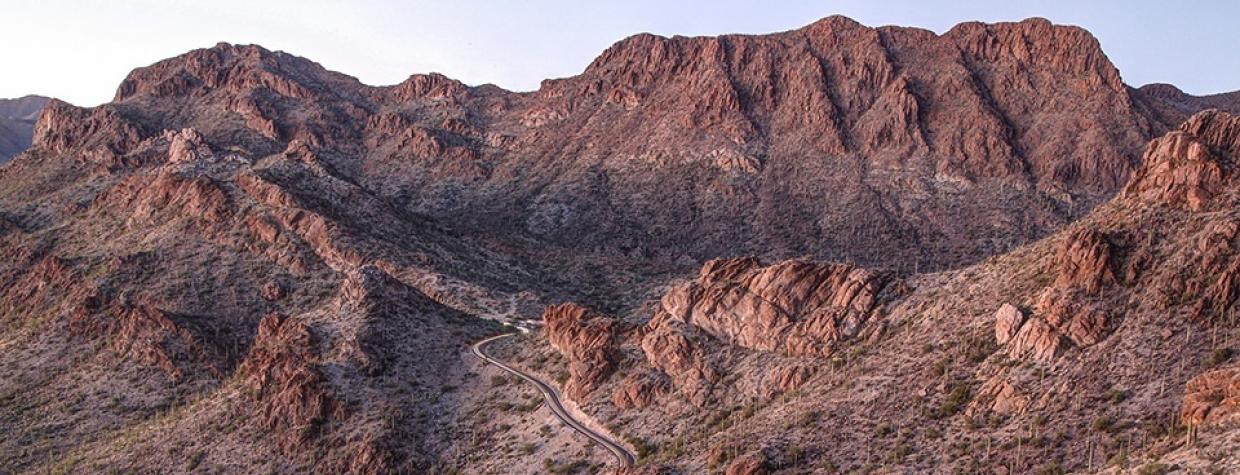Saguaro National Park and Tucson Mountain Park
Thanks to Old Tucson Studios, the Tucson Mountains have become synonymous with the Southwest, having provided the backdrop for countless movies and television shows. A 38.3-mile loop through Saguaro National Park West and Tucson Mountain Park, which includes Old Tucson, encompasses this iconic landscape, with towering saguaros, volcanic peaks, petroglyphs — even roadrunners and coyotes. And in March and April, the drive becomes even more picturesque as Mexican goldpoppies, orange globemallows and other wildflowers overlay its classic Sonoran Desert beauty.
From Interstate 10, we take Ina Road west to Wade Road. Within a few miles, we enter Saguaro National Park, thick with prickly pear and cholla cactuses, as well as the park’s namesake species. The Tohono O’odhams consider saguaros sacred, treating them as respected members of their tribe. And it’s easy to see why: Expressive arms lend the saguaros a human quality. They seem to shrug, raise their fists or bow with the graceful, curved arms of a dancer.
A Harris’ hawk soars high overhead, and we pick up an escort: a white-winged dove that seems to accompany us along the road, flashing its wing bars as it flits from one saguaro to another. These doves have an important relationship with the cactuses. When saguaros bloom in May and June, the doves flit between the flowers, sipping nectar and pollinating them. In June and July, they feed on the fruit, depositing the seeds under trees and shrubs that become nurse plants for the vulnerable young cactuses.
In the park’s Tucson Mountain District, the number of saguaros has increased by nearly 70 percent since 1990. Concerns about declining numbers led the park to institute a saguaro census in 1930, and the decline persisted through the 1960s. But if the current trend continues, scientists believe the forest will rebound to historical levels.
Continuing west on Picture Rocks Road, we leave Saguaro National Park, then turn left onto Sandario Road and re-enter the park. Now heading south, we pass unpaved Golden Gate Road, which leads to trailheads and two picnic areas built by the Civilian Conservation Corps in the 1930s. A short trail just north of one of these leads to dozens of petroglyphs at the top of Signal Hill.
Farther south, we pick up Kinney Road, which runs past the Red Hills Visitor Center before crossing into Tucson Mountain Park. This 37-square-mile park dates to 1929 and is one of the largest locally owned natural areas in the country. Kinney Road provides access to the Arizona-Sonora Desert Museum and Old Tucson Studios, both of which lease land from the park. It also accesses Gilbert Ray Campground via McCain Loop Road.
We turn left at Gates Pass Road, built in 1883 by saloonkeeper and miner Thomas Gates. It gently curves as it ascends to the Gates Pass Overlook. The scenic pullout is the park’s most popular destination, particularly at sunset.
From Gates Pass, the road descends into Tucson, past the castle-like turrets of the International Wildlife Museum. At Camino de Oeste, the road becomes Speedway Boulevard shortly before it reaches an intersection with I-10.
Note: Mileages are approximate.
Length: 38.3-mile loop
Directions: From Speedway Boulevard in Tucson, go northwest on Interstate 10 for 8 miles to Ina Road (Exit 248). Turn left onto Ina Road and continue 2.7 miles to Wade Road. Turn left onto Wade Road, which becomes Picture Rocks Road, and continue 7.2 miles to Sandario Road. Turn left onto Sandario Road and continue 3.9 miles to Kinney Road. Turn left onto Kinney Road and continue 2.7 miles to a “T” intersection. Turn left to stay on Kinney Road, then continue 3.8 miles to Gates Pass Road. Turn left onto Gates Pass Road, which becomes Speedway Boulevard, and continue 10 miles back to the starting point.
Vehicle Requirements: A high-clearance vehicle is recommended for Golden Gate Road.
Information: Saguaro National Park West, 520-733-5158 or www.nps.gov/sagu; Pima County Natural Resources, Parks and Recreation, 520-724-5000 or www.webcms.pima.gov

